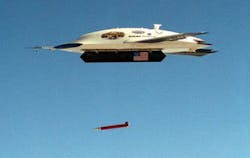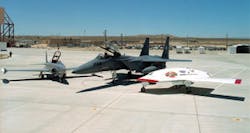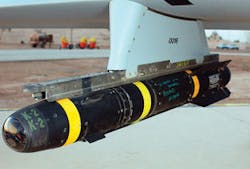By J.R. Wilson
Hunter-Killer: by most definitions, the term designates an entirely new class of UAV, not a weaponized sensor platform, such as the MQ-1 Predator, but an aircraft designed from the beginning to seek out and strike targets.
The original Air Force Request For Information in 2004 called for a high-altitude/long-endurance (HALE) aircraft capable of carrying a 3000-pound payload, including at least four 500-pound laser- or GPS-guided weapons, with long loiter time and an operating altitude between 35,000 and 50,000 feet. There were no specifications on speed or sensors.
The winner of the ensuing competition was General Atomics Aeronautical Systems in San Diego, builder of the highly successful Predator, with an aircraft it already had in test flight-the Predator B. In 2005, a heavy fuel Predator variant was selected for the Army’s Extended Range Multi-Purpose (ER/MP) program-another hunter-killer called Warrior.
In his September 2006 announcement naming the MQ-9 “Reaper,” distinguishing it from the MQ-1 Predator (General Atomics still calls it the Predator B), Air Force Chief of Staff Gen. T. Michael Moseley made it clear the U.S. military had entered a new era of UAV applications.
“The Reaper represents a significant evolution in UAV technology and employment,” said Moseley. “We’ve moved from using UAVs primarily in intelligence, surveillance, and reconnaissance (ISR) roles before Operation Iraqi Freedom to a true hunter-killer role with the Reaper.”
The first operational Reaper arrived at Creech Air Force Base, Nev., on March 13, 2007, laying the groundwork for the Air Force’s first MQ-9 unit-the 42nd Attack Squadron, part of the 432nd Wing, under which USAF’s existing MQ-1 Predator squadrons operate.
A Boeing Joint Unmanned Combat Air system (J-UCAS) X-45 aircraft releases an inert Global Positioning System-guided bomb at the Naval Air Warfare Center Weapons Division Range, China Lake, Calif.
“The 432nd is very excited about hunter-killers. Air Force fighter and bomber pilots (the required background for USAF UAV pilots) are very comfortable going out, flying aircraft, finding the bad guy, and shooting him,” says Col. David Whittemore, commander of the UAV Battle Lab at Creech and a former B-1 pilot. “But the hard part is the ISR-finding the bad guy, doing the ID, then doing what the commander wants done. If you can find them and track them, there are a lot more things you can do than drop a bomb on them-follow them, capture them, etc. Actually putting a bomb on them is the last resort, only if you think you’re going to lose them. So that’s where we have focused our efforts.”
While the UAV Battle Lab is scheduled to close in August, along with all other USAF battle labs in a major budget restructure, Whittemore says much of its mission will remain at Creech, as part of the Air Warfare Center. In terms of ongoing innovation in the field, that certainly will include the hunter-killer concept and whether, despite the designation and increased weapons capability, it is still primarily a weaponized ISR platform.
That is exactly how GA Aircraft Systems Group president Thomas J. Cassidy Jr. sees it, including the Reaper.
“I don’t think there is a lot of difference,” he says. “The Predator combines both missions and so does the Reaper. We’ve had Predators and Reapers work together and you can have several of each working together or with manned airplanes. It probably has a better detect capability than most manned aircraft, with a similar kill capability. But the reality is they are airplanes; the discriminator is very long endurance.”
But Ralph Starace, director of the Strike Market Segment at Northrop Grumman Integrated Systems in El Segundo, Calif., believes a true hunter-killer needs to be more than a weaponized ISR platform if it is to perform the specialized tasks warfighters will require of it.
“From a hunter-killer aspect, you’re talking about supporting the entire kill chain rather than just ISR,” he says. “The enabling technologies are things like sensor fusion, where we can use a variety of sensor capabilities, both on- and off-board systems, to get more-robust target detection and recognition and identification. You want to make sure you have a very confident level of ID so the operator can make the decision to go forward and prosecute the effect. That is a vital part of that equation, so the better we can get a highly confident ID, friend or foe, bus or tank, is critical. If it is the system being relied on to not only find, identify, track, and ultimately destroy a target, you want to make sure that capability is on board.
“If you are sending a UAV deep into a threat environment, you will want a decent magazine so it can take advantage of the hunter-killer aspect throughout the mission; you don’t want to run out of bullets. So you want to put more weapons on board, but there is a balance between that and the endurance and sensor payload and the aerodynamics, if externally stored. That would impact not only endurance but the ability to transit the battlespace, which is an important attribute of a hunter-killer-how long does it take the aircraft to reach a scene.”
Precision strike capabilities
At Air Combat Command, Maj. Steven “Gringo” Peak, the Air Force’s MQ-9 requirements chief, believes the Reaper is a perfect match for the two driving forces behind the hunter-killer concept: President Bush’s directives to provide new precision strike capabilities in the global war on terror and the Air Force interest in reducing the kill chain-find, fix, track, target, engage, and assess (F2T2EA)-with all of the information exchanges and command decisions entailed.
“F2T2EA-that’s what the MQ-9 does, all by itself,” he says. “But I don’t want to give the impression the MQ-9 can look at the entire theater or do this alone. Whether it is Global Hawk, U-2, satellite-some ISR partner has brought us to look at a certain area. The theater commanders then will decide to strike in that area, which is when the MQ-9 comes into play, going in with persistence to find that target.
“The operational template today is based on the MQ-9. For the future, there is an RFI out for a future UAS (unmanned aerial system), posted 19 April and asking for future technology-Tech Level 6-for what the next generation will be.”
At the same time, Peak seems in general agreement with Cassidy on the relationship between hunter-killers and ISR platforms.
Pictured from left to right are the J-UCAS T-33 flying test bed, the F-15E1 advanced technology demonstrator, and the J-UCAS X-45A at NASA’s Dryden Flight Research Center. (Courtesy of NASA)
“The ‘M’ in MQ-9 is multirole and we want to keep it that way. That gives the theater commander a platform he can use as he needs-weapons or sensors-and those would be interchangeable among other platforms,” says Peak. “We have resource constraints, so we don’t want to acquire something unique to one system. As a result, the MQ-9 uses sensors and weapons already in use by others. In the future, UAV systems will be like that as well, so when a new sensor or weapon comes along, it can just plug into the 1760 bus.
“That’s where we want to go for the future. We don’t want unique stuff. It just won’t work in the future acquisitions world. With the Air Force as the executive agent (for all UAVs), we can maintain acquisition control, frequency control, and make sure we aren’t acquiring two or three different things to do the same job. When a theater commander gets a system, he then can decide what to use it for-ISR heavy or strike heavy. But the platform should be multirole so he can make those decisions, rather than us making those decisions for him.”
That is how the Army sees Warrior-somewhere between Predator and Reaper in capability, with more weapons, range, and endurance than Predator, sharing common ground control with Shadow and interoperable with manned aviation platforms, especially the Apache helicopter.
“I would classify the Warrior as a hunter-killer, optimized for a combination of ISR and attack missions,” says Tim Owings, deputy project manager for Army UAS at the Army Aviation and Missile Life Cycle Management Command (AMCOM; Redstone Arsenal, Ala.). “From the ground up, Warrior had attack as a priority mission from inception, so it was never seen as an ISR-only asset, although it can be used for ISR; it is commanders discretion.
“We look at the UAV as a somewhat precision weapon, not for broad area attack. We carry four Hellfire missiles, so you are limited to four target launches. And there is a tradeoff between ISR and weaponization. Warrior is really built to carry a combination suite of capabilities-basic EO/IR and laser designator; SAR to see through clouds, smoke, and obscurance; communications relay and weapons. So it is truly a multi-use platform, with the kill side being only one- but a very important-mission.”
There also is some debate as to whether a hunter-killer is a single platform or two distinct platforms-one a hunter, the other a killer-perhaps with one in the air, the other on the ground, or one unmanned, the other manned. Two platforms would allow the hunter to be ISR heavy, the killer strike heavy, as Peak says. But if the number of platforms required is increased, what is the impact on cost and the complexity of operations for the ground-station crew?
“A key to all of this is affordability. If you are using a single system, you will need a larger platform, with a larger sensor suite-which is a larger part of the flyaway cost-plus a large magazine. The team approach would need smaller assets,” Starace says, a position not shared by everyone in a continuing debate over what actually constitutes a hunter-killer, from requirements to producability to application.
The Air Force, for example, strongly disagrees with the strike-heavy concept of a single-purpose killer.
“Any UAVs of interest to the Air Force will have to remain airborne much longer than they will have weapons,” Whittemore says. “UAVs will stay up a lot longer than a B-1 with fewer weapons, so they will run out of weapons long before they run out of gas. So UAVs are, first and foremost, hunters; I don’t think we’ll ever see UAVs loaded down with weapons and nothing else.”
A broader view
In some ways, the Army takes an even broader view than most.
“We see hunter-killer as a capability, as opposed to a system classification. By that, I mean there are multiple ways to implemenwt a hunter-killer philosophy, only one of which is direct weaponization of the platform,” Owings says. “There are applications where a nonweaponized UAV is linked to a killer-such as an Apache. A year and a half ago in Iraq, that typically occurred by handing off a target set by voice from a UAV operator to an Apache kill chain.
“Since then there has been a desire to reduce the kill chain. We have added laser pointers to our system so everything from small UAVs such as Ravens to larger platforms could spot the target on the ground with a laser point visible to the Apache crew. Now we are implementing laser designators on all our systems, especially the Shadow and Warrior class UAVs. We also are implementing weapons on Hunter and Warrior for direct kill in place. So you are creating a set of hunter and killer capabilities not linked to a particular platform.”
Keith Arthur, Teaming & Intelligent Systems team leader at the Army Aviation Applied Technology Directorate in Fort Eustis, Va., believes there are so many different ways to develop a hunter-killer concept that variants of them all probably will be seen in the next two decades. And many of the enabling capabilities will be developed, matured, and demonstrated at AATD to enable the Army Training and Doctrine Command (TRADOC) to experiment on the best way to employ them.
An AGM-114 Hellfire missile hung on the rail of an US Air Force (USAF) MQ-1L Predator Unmanned Aerial Vehicle (UAV) is inscribed with, “In Memory of Honorable Ronald Reagan.”
AATD recently tested the concept of multiple platforms-air and ground-working together as a hunter-killer team in an Unmanned Autonomous Collaboration Operations [UACO] demonstration at Fort Benning, Ga.
“What we did there was really a huge stride toward increasing the autonomy, the collaboration, the tactical intelligence of the UAV system,” Arthur says. “What we found was an increased level of tactical intelligence enables a human-in this case, an infantry company robotics NCO-to control and interact with a whole set of unmanned systems with a much lower workload than what goes on now for a single UAV.
“From our perspective, increasing the autonomy and collaborative capability of unmanned systems-ground and air-is what it will take to enable manned/unmanned teaming, the division of FCS (future combat system) to come to effective fruition and, as a by-product, enable a lot of different kinds of hunter-killer concepts to be substantiated.”
Level of autonomy
The potential level of autonomy for hunter-killers also has become somewhat controversial, with Hollywood and some news media articles and editorials suggesting that the military is moving toward a “Terminator” era in which robots will make kill decisions on their own. The one thing on which all the services agree is that is pure fiction-having a “man in the loop” making the final decision to strike and “pulling the trigger” will remain a mandatory part of any unmanned system.
This is not to say such systems will not continue to evolve in their ability to take some of the operational load off their human handlers.
“The reason you have highly trained operators now is it is not a simple task. The intent of the addition of autonomy is to try to remove that requirement from lower echelons,” notes AATD Systems Integration Division Chief Ray Wall. “The work we did under UACO was sponsored by the Dismounted Soldier Battle Lab. The intent was there should not be a full-time engagement to do your operation; you should be able to control the team and the units work in collaboration with each other to execute the task with little human intervention.
“The unmanned platforms can split up a problem, decide how to execute the task, get agreement with a single human operator handling an entire team of vehicles, then go out and perform the mission. Handling all of that from the front seat of an Apache was too much of a workload. So these technologies are intended to increase the cognitive decision-making software to handle minute-to-minute needs of a single UAV.
“We also are now looking at one-on-many, with a single operator giving various unmanned vehicles, air and ground, the mission, then they will split it up and determine which does what. The human operator can look at that and either agree with it or make changes. Once the operator agrees on a plan, the platforms go off and do it and the operator can continue with other matters and won’t be bothered by them until there is something to report.”
Another concept that may or may not fall into the hunter-killer arena is the Unmanned Combat Aerial Vehicle (UCAV), sometimes seen as a long-term replacement for manned fighter aircraft, but recently handed a setback when a joint Air Force/Navy program was scrapped. The Navy is continuing to pursue the concept, but it has now been placed on the back burner in the Air Force.
“A UCAV would do much of what an MQ-9 can do, but more next-generation and even more multirole, doing several missions at one time,” notes Maj. Troy Hoeger, ACC’s UAS chief engineer.
“There are gray areas in the definition of hunter-killer that are still being evolved as we understand and get smarter on what the capabilities can provide to the warfighter in terms of efficiencies and advantages,” adds Northrop Grumman’s Starace. “Clearly, the UCAV could be considered in the hunter-killer category from that standpoint-it has the search capability and the weapons on board to prosecute effect.”
GA’s Cassidy, however, sees a more distinct separation: “I think the UCAV is more of a killer than a hunter and won’t be designed for the long kill, where they can do a lot of hunting. They will be set off to attack things, so I don’t think it’s the same concept.”
Yet another coming change also may impact the future of hunter-killers-the Air Force becoming the executive agent for all U.S. military medium- and high-altitude UAVs.
The question is how the new approach will reconcile significant differences in how the services approach unmanned systems. The Air Force uses officers-active pilots-as heavily hands-on operators, while the Army seeks high levels of platform autonomy to allow its NCO operators to handle more platforms with less direct input. To date, those diverse philosophies have influenced the direction of development for each service’s hunter-killers. How having the Air Force as the sole executive agent will impact UAV programs overall-and hunter-killers in particular-remains to be seen.



